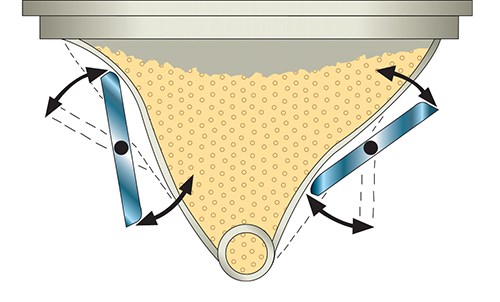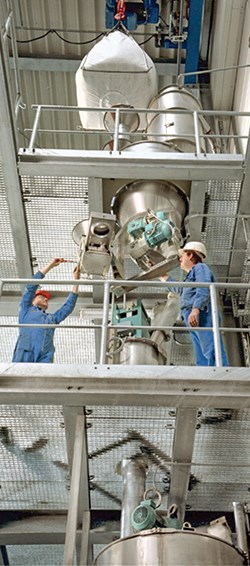Improve the Performance Of Your Gravimetric Feeder
Tips & Techniques
Start with seeing how well the material feeds 'volumetrically.' But there are a host of other considerations as well.
How can I improve my screw feeder’s gravimetric performance? As applications engineers, we get asked this question quite often.
In answering, the first thing you need to tell us is the material you are feeding. Gravimetric feeder performance is most always affected by how well the material feeds volumetrically. The closer you can fill the flights of the feed screw volumetrically to 100%, the better the feeder will perform gravimetrically. In order to get the material to feed better volumetrically, the material’s bulk characteristics must be analyzed first.
Let’s look at some of the most common material characteristics that affect volumetric feeder performance:
•Free-flowing: Plastic pellets are generally free-flowing materials. They feed under gravity without the need for special design considerations or flow enhancements.
•Adhesive: Some materials like to stick to everything. Pigments are notorious for adhering to all types of contact surfaces. Often we need to clean feed screws and tubes just to keep the material from building up on them. Avoid feeders with internal agitation systems. We may need to look at different coatings such as fluoropolymers or more polished contact services. Systems to self-clean the inside of the feed tube should be considered.
•Cohesive: These materials like to pack like a snowball and are typically associated with a high angle of repose. They need flow aids such as internal agitation, air sweeps, or air pads to create movement or external vibration to break up the clumps. Adding cross wires on the end of the feed tube to get the material to “pack” better into the flights of the feed screw can help.
•Aeratable /floodable: These materials are typically associated with a low angle of repose. They behave like a fluid when aerated and will easily flush out of a feed screw if it is not designed properly. A feed screw with a center rod vs. an open flight is often needed with these materials. I would recommend doing smaller refills more frequently with these types of materials versus a larger refill, which can often aerate the material in the feeder causing it to flood out.
•Hygroscopic: These materials retain moisture very easily. Often we hear customers say that they left material in the feeder and when they came back the next morning it had solidified because it had collected moisture from the environment. Blanketing the material with clean, dry air or nitrogen can help keep moisture out of the feeder.
•Pressure sensitive: These materials are prone to packing if used in large-volume hopper extensions. Again, frequent smaller refills may help keep the material from packing. Feeders that utilize external paddle agitation with flexible-walled hoppers require close attention to the level of frequency with which the paddles are agitating the hopper walls. Higher frequency agitation or vibration can often pack these materials.
•Low melt temp: These materials tend to break down, melt, or caramelize when excess friction/energy is used on them. I would recommend using a larger-diameter feed screw turning at a lower rpm than a smaller-diameter feed screw running at a higher rpm with these types of materials.
If all else fails, inquire about the testing capabilities of your material-handling equipment supplier. Often they have had experience feeding the material and can suggest ways of improving performance. Material testing is often free of charge and can be witnessed firsthand.
Now, after taking steps to improve material feeding volumetrically, let’s take a look at several factors that will affect the gravimetric performance of the feeder:
•Vibration: Vibration is detrimental to the operation of the gravimetric system because of the sensitivity of the scale, and special provisions must be taken to eliminate any vibration of the scale. Some possible ways to minimize vibration are to isolate the decking that the weighing system rests on; reinforce the decking around the weighing equipment so the decking flexes minimally; mount the weighing equipment on a high-mass pedestal (i.e., concrete-block table); mount the weighing equipment on vibration isolators; or mount the weighing equipment on structural members, not on the decking itself.
•Heating/ air conditioning/ventilation ducts: Heating, air conditioning, and ventilation ducts cause air disturbances, which could translate into false scale movements and changing scale weights. These ducts may need to be relocated away from the gravimetric system, especially for those systems with small load-cell capacities required for very accurate measurements.
•Open windows and doors: Like ventilation ducts, open windows and doors can create air disturbances that affect the gravimetric system. Special precautions may need to be taken to make sure that doors and windows, especially to the outside, remain closed.
•Ambient temperature: The air temperature where the gravimetric system—the scale, controller, and feeder—is going to be placed must not exceed the temperature limit in the scale system’s specifications, since load cells are temperature compensated.
•Hazardous areas: Provisions for the class, division, and group of hazardous areas must be taken into consideration. These areas typically require intrinsic barriers within the feeding system, which will degrade the raw signal of the load cell due to the voltage drop across the barrier.
•Electrical power: The controller of the gravimetric system requires “clean power” much as a computer requires a clean line. This line should be free from any large inductive or capacitive loads. If uncertain about the condition of supply power, an isolation transformer or UPS (uninterruptible power supply) is recommended.
•Large inductive and/or capacitive equipment: The scale and the scale cables (excitation and signal) must be separated from large inductive and/or capacitive loads, such as arc welders, large motors, etc.
•AC voltage power wiring: All cables associated with the gravimetric system should be run in separate conduit from all high-voltage AC signals.
•Radio-frequency equipment: The scale and the scale cables must be isolated from RF-generating equipment.
•Support systems: The floor, balcony, mezzanine, etc., on which the gravimetric system is mounted must have a rigid construction to provide a solid platform, as mentioned earlier.
•Distance from the feeder and scale to the controller: For distances greater than 25 ft, contact the manufacturer for cabling recommendations.
•Electrical ground: A solid electrical ground must be available for the feeder and the electrical controller.
•Scale/feeder mounting: The mounting table or mounting base for the scale must be solid and preferably afford some vibration isolation between the scale and the floor.
•Outdoor installations: If any gravimetric equipment is to be installed outdoors, extreme temperature variations should be avoided if at all possible. Cabinet heaters may be required to keep the controller and the load cells at a nominal temperature.
•Flexible connections: Any electrical, plumbing, or other connections to the gravimetric feeder must be made with flexible conduit/piping/tubing to have minimal effect on the movement of the gravimetric scale. Use factory-recommended flexible connectors for feeder inlet and discharge ends when the scale system is part of a gravimetric feeder.
•Maintenance access: Consideration should be given to allow maintenance personnel access to maintain the scale, gravimetric feeder, and controller.
•Corrosive atmospheres: Any corrosive vapors, dust, etc., should be noted and recommendations should be given on how to prevent corrosion by using resistant materials.
•Refill mechanism: The mechanism used to automatically refill gravimetric feeders must be tight-closing so the material cannot enter the feeder’s extension hopper other than during the refill time. In addition, the refill device must be sized to refill the required amount of material so the feeder does not starve out.
•Refill venting: Rapid introduction of dry material into a feeder hopper extension during a refill causes pressure to build up inside the hopper extension equivalent to the volume of air displaced by the volume of dry material. This pressure must be relieved, either by leaving the refill gate open so the displaced air can move into the refill hopper, or by providing a vent in the feeder hopper extension.
•Vacuum systems: Vacuum or pressure systems, either at the infeed or discharge of a feeder, may affect the gravimetric system by causing adverse suction or pressure on the system. These ancillary systems must be properly vented to prevent these conditions.
Related Content
Software Helps Processors Make Better Business Decisions
NPE2024: Tracker Monitoring and Reporting Software supports ISO reporting and material validation, including PCR usage and equipment status monitoring.
Read More'Simple' Units Feature State-of-the-Art Controls
NPE2024: New dryer line from Motan billed as the most cost-effective entry-level models it offers and comes equipped with state-of-the-art control technology.
Read MoreFeeder Line Offers Processors More Flexibility
Line features a single touchscreen for easy setup and operation.
Read MoreFeeders Now Furnished With Portable Touchscreen Controller
New portable controller maintains functionalities of previous controller while introducing significant enhancements.
Read MoreRead Next
People 4.0 – How to Get Buy-In from Your Staff for Industry 4.0 Systems
Implementing a production monitoring system as the foundation of a ‘smart factory’ is about integrating people with new technology as much as it is about integrating machines and computers. Here are tips from a company that has gone through the process.
Read MoreBeyond Prototypes: 8 Ways the Plastics Industry Is Using 3D Printing
Plastics processors are finding applications for 3D printing around the plant and across the supply chain. Here are 8 examples to look for at NPE2024.
Read MoreLead the Conversation, Change the Conversation
Coverage of single-use plastics can be both misleading and demoralizing. Here are 10 tips for changing the perception of the plastics industry at your company and in your community.
Read More

















